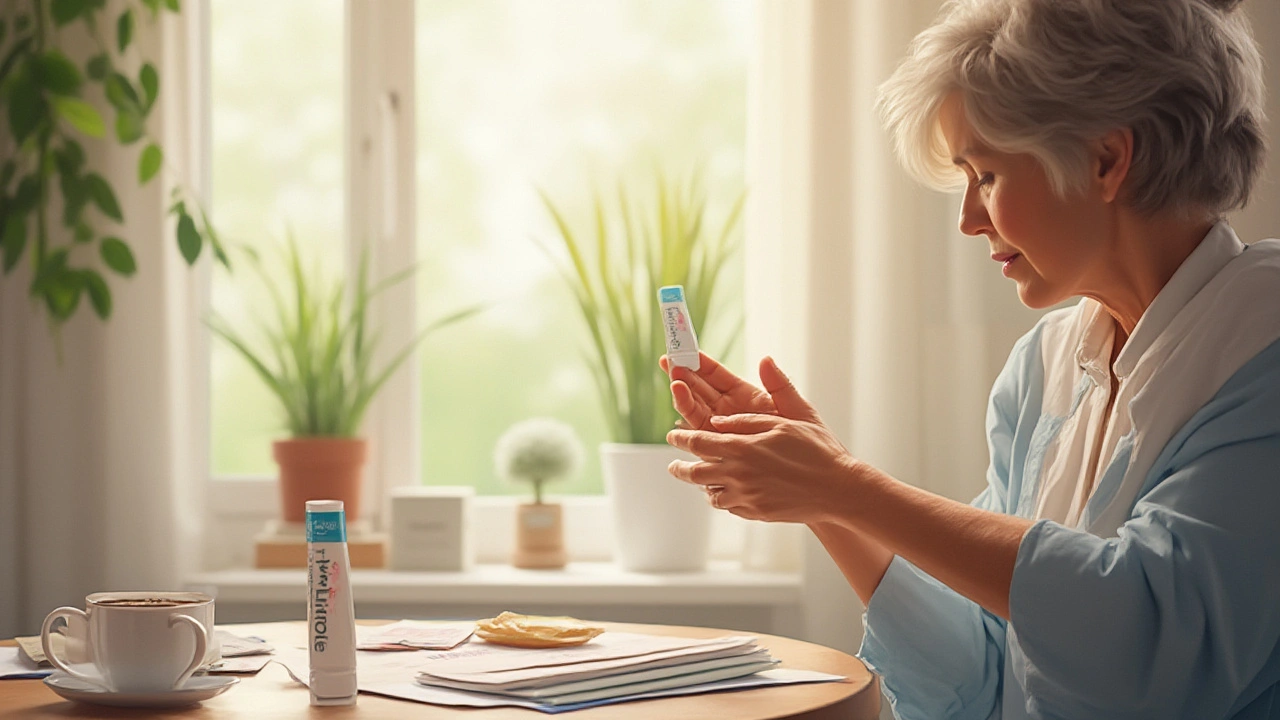Sometimes, the smallest things create the biggest changes. Picture this: a tiny packet of cream, nearly invisible among your bathroom stash, could actually coach your immune system into fighting off stubborn and embarrassing skin problems. That's the case with Imiquad cream. Forget the one-size-fits-all solutions. Here's a topical treatment that nudges your body's defenses without just blasting your skin with chemicals. Sounds impressive? There’s more to uncover under the surface.
What is Imiquad Cream and How Does It Work?
Imiquad cream, packed with the active ingredient imiquimod, isn’t your average over-the-counter ointment. It’s a prescription med, squarely aimed at challenging skin issues that can mess with your day-to-day and—for many—confidence. What's different about Imiquad is that it doesn't kill viruses or abnormal cells in the old-fashioned 'chemical warfare' style. Instead, it motivates your own immune cells to clean house.
So, how does it work? The cream acts as an immune response modifier. When you rub it onto your skin, imiquimod interacts with immune cells locally, triggering them to release natural messengers called cytokines—especially interferon-alpha. This chemical pep talk to the immune system helps your body spot and destroy virus-infected or cancerous cells in the skin. It’s not a sledgehammer; it’s more like a wake-up whistle that tells your immune guards to get moving.
The FDA gave Imiquad’s close cousin, Aldara (both have imiquimod 5%), the green light for conditions like external genital and perianal warts, actinic keratosis, and superficial basal cell carcinoma. In fact, it's this immune-boosting angle that makes Imiquad unique compared to cryotherapy, acids, or surgery.
But even with all this science, people often wonder: why can’t we just use antibiotic or antiviral creams? The answer—Imiquad fills a special gap. Most standard creams don’t prompt a strong immune response. Imiquad does, and that means it can tackle persistent warts caused by HPV, pre-cancerous sun spots (actinic keratoses), and even early-stage skin cancer patches as an alternative to cutting or burning. That’s a whole new ballgame, right?
Dig a little deeper, and you’ll bump into some facts you might not expect. For example, one study published in the “Journal of the American Academy of Dermatology” found clearance rates of over 70% for genital and perianal warts using imiquimod cream, with a quoted expert highlighting,
"Imiquimod’s unique host-modulating properties make it a valuable tool for HPV-related skin disease, especially when traditional medicines fall short."
Common Uses of Imiquad Cream
This little tube or sachet is most famous as a foe for genital and anal warts (caused by certain pesky strains of HPV). Doctors often reach for Imiquad when other wart-removal tactics turn into a frustrating cycle. But it's not just for those awkward spots. It’s become a big player in the toolkit for two other main skin troubles: actinic keratosis and superficial basal cell carcinoma.
Imiquad cream is approved for and most commonly used in three key scenarios. Check them out:
- External genital and perianal warts: Some warts just won't quit, no matter how many times you freeze or burn them. Imiquad gives your local immune army a nudge, helping many people clear wart clusters within weeks to months. It's not instant, but for stubborn warts, it changes the game.
- Actinic keratosis (AK): These rough, scaly patches are often a red flag from your sun-drenched past—they're very common on the face, scalp, forearms, and hands of folks with fair skin. AKs can turn into squamous cell carcinoma over time. Imiquad boosts the immune system to attack abnormal cells before they get a chance.
- Superficial basal cell carcinoma (sBCC): You might not know there are different types of skin cancer. The 'superficial' kind grows slowly on the surface. Some people aren’t great candidates for surgery or just want to avoid scars on visible areas. Enter Imiquad—it gives them a shot at treatment with less drama than a scalpel and stitches.
Some off-label uses have popped up too. Dermatologists may sometimes prescribe it for stubborn molluscum contagiosum (especially in adults), Bowen’s disease, and even complicated wart outbreaks in difficult areas. And let's not forget: Imiquad isn’t magic, but it’s given hope where scars or relapses used to be the norm.
Tips from clinics consistently highlight: always use Imiquad on dry, clean skin; wash your hands before and after; and don’t skimp or double the dose. More cream doesn't mean better or faster results—in fact, overdoing it almost always means more side effects (think stinging, redness, or swelling). Most doctors suggest spreading a thin film at bedtime, letting it do its thing overnight (about 6-10 hours), and then washing it off in the morning. Stick with your schedule.

Applying Imiquad Cream: What Works and What to Avoid
If you want results, you have to nail the routine. Mess it up and you might waste the cream—or worse, irritate your skin into a frenzy. Every Imiquad box comes with exact instructions, but sometimes people miss key points. Here’s how to get it right, according to dermatology pros and patients who’ve been there, done that:
- Frequency: This isn’t an everyday cream. For genital or perianal warts, typical use is three times a week (for example, Monday, Wednesday, Friday). For actinic keratosis, it’s usually twice a week. Follow your doctor’s orders!
- Amount: Don’t go big. Squeeze out just enough to cover the actual lesion(s)—not surrounding healthy skin. Think a thin layer, not a white blob. Rubbing it in too hard can make the skin angry.
- Contact times: It should stay on the skin for 6–10 hours, usually overnight. Set a phone timer if you tend to forget in the morning.
- After care: Gently wash off with mild soap and water when the time’s up. Don’t scrub. Skin is likely to be red or a bit sore; that's normal. If you see pus, intense swelling, or blistering, call your doctor.
- Protect: Avoid covering the area with plastic wraps or bandages. Tight undies can trap heat and intensify irritation. Loose, cotton clothing is your friend.
- Avoid: Keep the cream away from eyes, nostrils, lips, and inside the anus or vagina. Seriously—this stuff isn’t meant for mucous membranes (the inside of body openings), only the skin itself.
Some people quit too soon when their skin starts looking angry and raw. That’s often when the medicine is working hardest. Don’t stop unless your doctor says you should—or you see signs of infection. Take photos of progress along the way; it really helps at checkups to show your dermatologist what’s changing (or not).
People on Reddit and patient forums often share secrets for surviving the rough spells: cool compresses help, and skipping a dose or spacing them further apart can calm irritation. Doubling up, on the other hand, never ends well. If side effects spin out of control, like weeping sores or fevers, get checked out. Your doctor might hit pause or change your protocol, but rarely does anyone need hospital care.
Possible Side Effects: What to Expect With Imiquad
This is where things get real. Imiquad cream is tough on trouble spots because it stirs up inflammation right at the source. The consequence? Most people deal with some degree of redness, soreness, flaking, or even blisters. It’s not allergic; it’s just the immune army going hard at the enemy.
Here’s what turns up most often:
- Redness and swelling: Almost everyone gets it. Mild to moderate is normal; severe cases do happen, especially if you use too much or have sensitive skin.
- Burning, itching, or tingling: This can be annoying but tends to fade over time as your skin adjusts.
- Scabbing or crusting: Yes, it looks gross. That’s your body clearing out dead tissue.
- Weeping or ulceration: Rare, but possible—especially with overuse or if skin is fragile. Take a break and tell your doctor if you see open sores.
- Systemic symptoms: Rarely, you might feel tired, feverish, or get flu-like aches. It usually means your immune system is really ramping up. Have a conversation with your doctor if this kicks in.
Not all side effects are bad news; in fact, dermatologists often reassure folks that “no reaction” can sometimes mean “no strong immune response.” So paradoxically, some visible signs are proof the cream is talking to your immune guards.
Long story short: Imiquad isn’t subtle, but its side effects usually fade after a course is complete. Some people end up with lighter or darker patches where the cream was used, a souvenir of the immune battle that fades with time. Permanent scarring is rare, especially if you treat the area gently and skip harsh lotions, makeup, or exfoliators during the cycle.

Tips, Myths, and Final Thoughts: Making the Most of Imiquad Cream
If you're staring down a course of Imiquad, here are some pro tips straight from the trenches:
- Take progress photos: Snapshot your spots at every step. It’s hard to judge slow changes by memory alone, and your dermatologist will thank you.
- Timing is everything: Don’t fudge on the night vs. morning cycle. Washing off too late or too early changes results.
- Moisturize (but wisely): Ask your doc about using plain petroleum jelly or a gentle, fragrance-free moisturizer once lesions start to heal. Don’t smother fresh, raw skin with fancy products.
- Avoid sun: Your treated skin will react more to sunlight. Even with cloudy skies, use a wide-brimmed hat or stay inside.
- Tough love: The red, bumpy, crusty stage usually means it’s working. Keep going unless your doctor pulls the plug.
People still wonder, why does it work on some but not others? Genetics, immune health, and the nature of the skin lesion all play a role. Some tough warts need several cycles. Some actinic keratoses disappear in a week, others linger a month or more. Patience really pays off.
There are a few myths worth busting too. Using more cream won’t speed up healing; it just irritates your skin into a mess. Skipping prescribed nights backfires—partial treatment is a big reason for relapses. And no, bombarding normal skin “just in case” is a terrible idea. Imiquad is not a facial or an over-the-counter beauty hack. Every application should be supervised by your dermatologist, at least the first time around.
So, Imiquad cream—it’s no miracle in a tube, but it can outsmart tricky viruses and early skin cancers using your own immune system as a partner. Skincare routines don’t get more high-stakes. Stick with the plan, ask questions, and trust the red flags. For people who’ve seen every treatment fail, Imiquad might just be the underdog that finally works.


Post A Comment